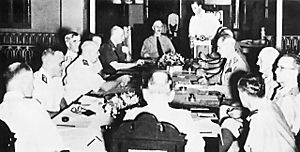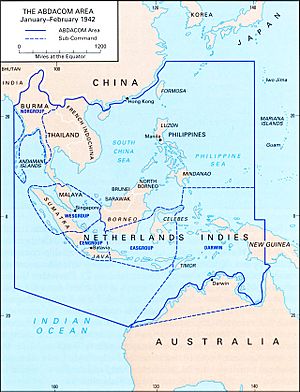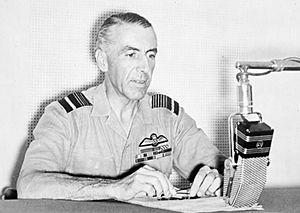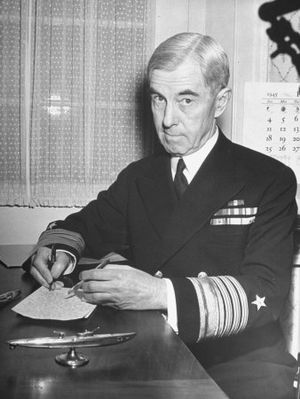American-British-Dutch-Australian Command facts for kids
The American-British-Dutch-Australian (ABDA) Command, also called ABDACOM, was a special military group formed in early 1942 during World War II. It was a short-lived command for all the Allied forces in South East Asia. The command included soldiers, sailors, and airmen from Australia, the Netherlands, the United Kingdom, and the United States.
General Sir Archibald Wavell led ABDACOM. Its main goal was to protect the "Malay Barrier". This was an imaginary line that went through the Malay Peninsula, Singapore, and the southern islands of the Dutch East Indies. ABDACOM was also known as the "South West Pacific Command" by the British. But it was different from a later command called the South West Pacific Area.
Even though ABDACOM only lasted a few weeks and faced many defeats, it taught important lessons. These lessons helped the Allies work better together in later parts of the war.
Contents
Why ABDACOM Was Formed
Efforts to create the ABDA Command began soon after Japan attacked the Allies on December 7, 1941. Leaders like Army Chief of Staff George C. Marshall wanted to unite all Allied forces under one command. They had seen how separate commands led to defeats in places like France and at Pearl Harbor.
The idea for ABDACOM was agreed upon at the Arcadia Conference in Washington. On December 27, Marshall suggested that General Archibald Wavell should lead the new command. British military leaders were not sure about this plan. They thought the Pacific area was too big for one commander to control.
Winston Churchill, the British Prime Minister, also had doubts. He reminded Marshall of the difficulties faced by Ferdinand Foch in World War I. Foch had struggled to coordinate armies on the Western Front. But Marshall insisted on a united front against Japan. Churchill then reluctantly agreed.
On January 1, 1942, the four Allied nations officially appointed Wavell as the supreme commander. This meant Wavell was in charge of a very large area. It stretched from Burma in the west to Dutch New Guinea and the Commonwealth of the Philippines in the east. Other areas, like India and Hawaii, stayed under separate commands. General Douglas MacArthur kept full control of Allied forces in the Philippines. Wavell also insisted that North West Australia be added to the ABDA area.
Challenges Faced by ABDACOM
ABDACOM was tasked with holding the Malay Barrier. This was to keep the Indian Ocean and the sea routes to Australia safe. But this was a very difficult job. Japan had much stronger naval forces in the western Pacific.
Many other problems made the task harder:
- Burma was added to the command, which was a new challenge.
- The forces were from four different countries. They used different equipment and had not trained together.
- Each country had its own priorities. The British wanted to protect Singapore.
- The Dutch forces in the Dutch East Indies were weaker because the Netherlands had been defeated by Nazi Germany in 1940. They focused on defending Java.
- Australia was busy fighting in North Africa and Europe. It had few soldiers available nearby.
- The United States was focused on defending the Philippines, which was a U.S. territory.
Wavell arrived in Singapore on January 7, 1942. His headquarters later moved to Lembang on Java. On January 24, U.S. Navy forces under ABDACOM attacked Balikpapan, Borneo. They sank six Japanese transport ships. However, this did not stop Japan from capturing the oil wells in Borneo.
ABDACOM's End
The Japanese attacks were very fast and strong. Allied resistance quickly collapsed in Malaya, Singapore, the Dutch East Indies, and the Philippines. The Malay Barrier was soon broken.
Singapore fell on February 15, which greatly weakened ABDACOM. The command was officially dissolved a week later.
Wavell stepped down as supreme commander on February 25, 1942. He gave control of the ABDA Area back to local commanders. He also suggested creating two new Allied commands: one for the South West Pacific and one based in India. Wavell then returned to his old job as Commander-in-Chief India.
ABDACOM effectively ended after the Battle of the Java Sea in February–March 1942. In this battle, the ABDA naval strike force was destroyed by the Japanese.
As the Imperial Japanese Army closed in on the Philippines, General MacArthur was ordered to move to Australia. On March 17, the U.S. government made him Supreme Allied Commander of the South West Pacific Area. This new command included Australia and New Guinea. The rest of the Pacific area was under the Pacific Ocean Areas command, led by Admiral Chester Nimitz of the U.S. Navy.
One notable success for ABDA forces was the guerrilla campaign in Timor. Australian and Dutch soldiers fought for almost a year after the Japanese landed there on February 19.
Official Command Structure
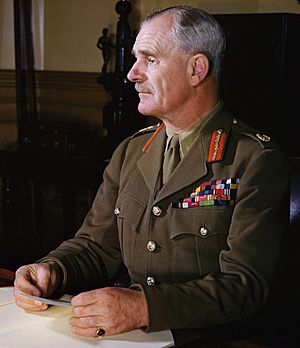
General Sir Archibald Wavell, British Army (BA) – Supreme Commander
- Lieutenant General George H. Brett, U.S. Army Air Forces (USAAF) – Deputy Commander
- Lt Gen. Henry Pownall (BA) – Chief of Staff
Land Forces (ABDARM)
- Lt Gen. Hein ter Poorten, Royal Netherlands East Indies Army (KNIL) – Commander of Land Forces (ABDA Land)
- Major General Ian Playfair (BA) – Deputy Land Commander
- Maj. Gen. T. J. Hutton (BA) – British forces in Burma
- Maj. Gen. David Blake, Australian Army, Australian 7th Military District (Northern Australia)
- Lt Gen. Arthur Percival (BA) – Malaya Command
- Gen. Douglas MacArthur, United States Army – Allied forces in the Philippines
(Even though MacArthur was technically under Wavell, many commands often worked on their own.)
Air Forces (ABDAIR)
- Air Marshal Sir Richard Peirse, Royal Air Force (RAF) – Commander of Air Forces (ABDA Air)
- Maj. Gen. Lewis H. Brereton (USAAF) – Deputy Commander Air Forces
- Air Vice-Marshal Sir Paul Copeland Maltby RAF – Air Officer Commanding RAF in Java
- Air Vice-Marshal D. F. Stevenson RAF – NORGROUP (RAF: Burma)
- Air V. Marshal C. W. Pulford RAF – WESGROUP (RAF: Malaya and North Sumatra)
- Maj. Gen. Ludolph van Oyen (KNIL) – Allied Air Forces Java (after February 22)
- Air Commodore D. E. L. Wilson, Royal Australian Air Force – AUSGROUP (RAAF: North-Western Australia, Molucca Sea & Dutch New Guinea)
- Maj. Gen. Lewis H. Brereton (USAAF) – Deputy Commander Air Forces
- Admiral Thomas C. Hart, U.S. Navy (USN) – Commander of Naval Forces (ABDA Sea). (Until February 12, 1942.)
- Adm. Conrad Helfrich, Royal Netherlands Navy (RNN). (After February 12, 1942.)
- Rear Admiral Arthur Palliser, (British) Royal Navy – Deputy Commander Naval Forces
- R. Adm. William A. Glassford, Jr. (USN) – Commander U.S. Naval Forces
- R. Adm. Johan van Staveren (RNN) – Commander Dutch Naval Forces
- Commodore John Collins, Royal Australian Navy – Commander British-Australian Naval Forces
- Rear Admiral Arthur Palliser, (British) Royal Navy – Deputy Commander Naval Forces
Allied Ships Under ABDACOM
American Ships
- USS Houston (CA-30) - lost
- USS Marblehead (CL-12) - heavily damaged
- USS Boise (CL-47)
- USS Alden (DD-211)
- USS Barker (DD-213)
- USS John D. Edwards (DD-216)
- USS Whipple (DD-217)
- USS Parrott (DD-218)
- USS Edsall (DD-219) - lost
- USS Bulmer (DD-222)
- USS Stewart (DD-224) - lost
- USS Pope (DD-225) - lost
- USS Peary (DD-226) - lost
- USS Pillsbury (DD-227) - lost
- USS John D. Ford (DD-228)
- USS Paul Jones (DD-230)
- USS Asheville (PG-21) - lost
- USS Tulsa (PG-22)
- USS Holland (AS-3)
- USS Canopus (AS-9) - lost
- USS Otus (AS-20)
- USS Langley (CV-1) - lost
- USS Childs (AVD-1)
- USS Heron (AVP-2)
- Lanikai (converted yacht)
- USS Pecos (AO-6) - lost
British Ships
- HMS Prince of Wales - lost
- HMS Repulse - lost
- HMS Exeter - lost
- HMS Dragon
- HMS Danae
- HMS Durban
- HMS Emerald
- HMS Electra - lost
- HMS Encounter - lost
- HMS Express
- HMS Isis
- HMS Jupiter - lost
- HMS Scout (1918)
- HMS Stronghold - lost
- HMS Tenedos - lost
- HMS Thanet - lost
Dutch Ships
- HNLMS De Ruyter (1935) - lost
- HNLMS Tromp (1937)
- HNLMS Java (1921) - lost
- HNLMS De Zeven Provinciën (1909) - lost
- HNLMS Evertsen (1926) - lost
- HNLMS Kortenaer (1927) - lost
- HNLMS Piet Hein (1927) - lost
- HNLMS Van Ghent (1926) - lost
- HNLMS Banckert (1929)
- HNLMS Van Nes (1930) - lost
- HNLMS Witte de With (1928) - lost
Australian Ships
- HMAS Perth (D29) - lost
- HMAS Hobart (D63)
- HMAS Adelaide (1918)
- HMAS Vampire (D68) (ex. HMS Vampire) - lost
- HMAS Vendetta (D69)
See Also


